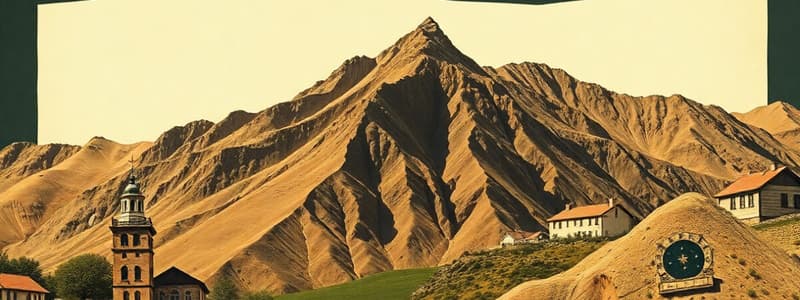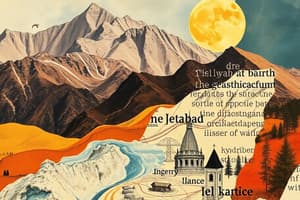Podcast
Questions and Answers
The study of how the Earth's atmosphere, lithosphere, hydrosphere, and biosphere interact is best described as which type of approach?
The study of how the Earth's atmosphere, lithosphere, hydrosphere, and biosphere interact is best described as which type of approach?
- Systems (correct)
- Reductionist
- Deterministic
- Holistic
Which of the following scenarios best illustrates the impact of deforestation on other Earth systems?
Which of the following scenarios best illustrates the impact of deforestation on other Earth systems?
- Increased soil erosion and altered regional climate patterns. (correct)
- Increased volcanic activity due to reduced soil stability.
- Reduced ocean salinity due to increased freshwater runoff.
- Decreased atmospheric carbon dioxide levels leading to global cooling.
A region experiencing significant chemical weathering likely exhibits which of the following characteristics?
A region experiencing significant chemical weathering likely exhibits which of the following characteristics?
- High temperatures and abundant moisture. (correct)
- Extensive glacial activity.
- Arid climate with strong winds.
- Dominance of freeze-thaw cycles and abrasion.
Which of the following best exemplifies the study of biogeography?
Which of the following best exemplifies the study of biogeography?
How does urbanization typically affect the local climate of a region?
How does urbanization typically affect the local climate of a region?
Which process is most directly responsible for the creation of sedimentary rocks?
Which process is most directly responsible for the creation of sedimentary rocks?
What is the primary focus of climatology as a subfield of physical geography?
What is the primary focus of climatology as a subfield of physical geography?
Which of the following best describes the role of the hydrosphere in regulating Earth's climate?
Which of the following best describes the role of the hydrosphere in regulating Earth's climate?
How do internal processes, such as plate tectonics, primarily shape the Earth's surface?
How do internal processes, such as plate tectonics, primarily shape the Earth's surface?
What is the primary focus of pedology in the context of physical geography?
What is the primary focus of pedology in the context of physical geography?
Flashcards
What is Geography?
What is Geography?
The study of Earth's surface, features, climate, and resources.
Physical Geography
Physical Geography
Focuses on the natural environment, including landforms, climate, and ecosystems.
Geomorphology
Geomorphology
Studies landforms, their origin, evolution, and the processes that shape them.
Climatology
Climatology
Signup and view all the flashcards
Hydrology
Hydrology
Signup and view all the flashcards
Biogeography
Biogeography
Signup and view all the flashcards
Pedology
Pedology
Signup and view all the flashcards
Atmosphere
Atmosphere
Signup and view all the flashcards
Lithosphere
Lithosphere
Signup and view all the flashcards
Hydrosphere
Hydrosphere
Signup and view all the flashcards
Study Notes
- Geography studies the Earth's surface, including physical features, climate, population, and resources.
- It analyzes spatial relationships between people and their environment.
- Geography is divided into physical and human geography.
Physical Geography
- Focuses on the natural environment
- Studies Earth's physical features and processes, including landforms, climate, weather, soil, plants, and animals
- Key areas include geomorphology, climatology, hydrology, biogeography, and pedology
Geomorphology
- Studies landforms, their origin, evolution, and the processes that shape them
- Involves understanding tectonic forces, weathering, erosion, and deposition
- Landforms include mountains, valleys, plains, coastlines, and deserts
- Analyzes changes over time due to natural processes and human activities
Climatology
- Studies long-term weather patterns and factors influencing climate like latitude, altitude, and ocean currents
- Analyzes temperature, precipitation, wind patterns, and atmospheric variables
- A major focus is understanding climate change and its impacts
Hydrology
- Studies water on Earth, including its distribution, movement, and properties
- Includes surface water, groundwater, and the water cycle.
- Focuses on water resources, water quality, and human impacts on water systems
- Addresses issues like flooding, drought, and water management
Biogeography
- Studies the distribution of plants and animals and factors influencing geographic patterns
- Factors include climate, topography, soils, and historical events
- Focuses on ecosystems, biodiversity, and the impacts of human activities on species distribution
- Considers how species evolve and adapt to different environments
Pedology
- Studies soils, their formation, classification, and properties
- Focuses on soil composition, texture, structure, and fertility
- Understanding soil is crucial for agriculture, forestry, and environmental management
- Analyzes how soils are affected by climate, vegetation, and human activities
- Studies soil conservation and land use planning
Systems in Physical Geography
- Uses a systems approach, viewing Earth as interconnected systems
- Includes the atmosphere, lithosphere, hydrosphere, and biosphere
- Changes in one system can affect others; deforestation can affect climate and soil erosion
Atmosphere
- The layer of gases surrounding the Earth, composed mainly of nitrogen and oxygen
- Protects Earth from harmful radiation and regulates temperature and weather
- Involves processes like radiation, convection, and advection
- Human activities, such as burning fossil fuels, can alter its composition
Lithosphere
- Earth's rigid outer layer, including the crust and uppermost part of the mantle
- Divided into tectonic plates that move and interact
- Plate tectonics cause earthquakes, volcanoes, and mountain building
- Contains rocks, minerals, and soils
Hydrosphere
- Includes all forms of water: oceans, lakes, rivers, groundwater, ice, and water vapor
- Plays a crucial role in regulating climate and distributing heat
- The water cycle describes the continuous movement of water between the atmosphere, land, and oceans
- Human activities can affect water quality and availability
Biosphere
- Includes all living organisms on Earth, encompassing all ecosystems
- Interacts with the other spheres, influencing climate, soil formation, and nutrient cycling
- Biodiversity is an important aspect
- Human activities can threaten biodiversity and disrupt ecosystems
Processes Shaping the Earth
- Internal processes, such as plate tectonics and volcanism, shape the Earth's surface
- External processes, such as weathering and erosion, wear down and modify landforms
Weathering
- The breakdown of rocks and minerals at the Earth's surface
- It involves both physical and chemical processes
- Physical weathering includes processes such as freeze-thaw cycles and abrasion
- Chemical weathering involves reactions between rocks and water or air
- Creates sediments that can be transported and deposited elsewhere
Erosion
- The removal and transport of weathered materials
- Caused by agents such as water, wind, ice, and gravity
- Water erosion includes processes such as river erosion and coastal erosion
- Wind erosion is common in arid and semi-arid regions
- Glacial erosion occurs in mountainous and polar regions
- Gravity-driven erosion includes landslides and mass wasting
Deposition
- The settling and accumulation of sediments
- Occurs when the transporting agents lose energy
- Sediments can be deposited in rivers, lakes, oceans, and other environments
- Over time, deposited sediments can be compacted and cemented into sedimentary rocks
Human Impact on Physical Geography
- Human activities have a significant impact on the physical environment
- Deforestation, agriculture, urbanization, and industrialization can alter landforms, climate, and ecosystems
Deforestation
- The clearing of forests for other land uses
- It can lead to soil erosion, loss of biodiversity, and climate change
- Reduces the amount of carbon dioxide absorbed by trees
Agriculture
- Agricultural practices can affect soil quality, water resources, and biodiversity
- Irrigation can deplete water supplies and lead to soil salinization
- The use of fertilizers and pesticides can pollute water and harm wildlife
Urbanization
- The growth of cities and urban areas
- Can lead to habitat loss, air pollution, and water pollution
- Urban areas often have higher temperatures than surrounding rural areas (urban heat island effect)
Industrialization
- Industrial activities can release pollutants into the air, water, and soil
- Burning fossil fuels contributes to air pollution and climate change
- Mining activities can alter landforms and contaminate water resources
Importance of Studying Physical Geography
- Understanding physical geography is essential for managing natural resources
- It also helps in mitigating environmental hazards
- It is important for sustainable development
- Knowledge of physical geography can help address issues such as climate change, water scarcity, and land degradation
- It informs land use planning, conservation efforts, and disaster preparedness
Studying That Suits You
Use AI to generate personalized quizzes and flashcards to suit your learning preferences.




